Ducati has introduced the entirely redesigned Monster 1200 and 1200 S. In response to the increasingly competitive super naked category, each of the new models features 150 horsepower (peaking at 9,250 rpm). The standard 1200 has fully adjustable suspension and Brembo brakes, but the 1200 S comes stock with Öhlins fork and shock, as well as the awesome Brembo M50 front calipers.
The Monster 1200 will be available in January of next year priced at $14,695 (available only in Red), while the 1200 S is priced at $16,995 in Red and $17,195 in Gray. Here is the full press release from Ducati:
Ducati goes back to its Monster roots, but with a motorcycle that’s new in both form and function. When Ducati designers started working on the new Monster 1200, they drew their inspiration from the basics behind that ground-breaking 1993 model: the concept of a “sport naked bike”.
The Monster 1200 is packed with new design and content, but with true Ducati naked flair. Available also as a higher-performance S version, the Monster 1200 has a sleeker tank, a fully redesigned sports-style tail, an all-new technologically advanced headlight and a first-rate electronics package derived from the one on the 1299 Panigale.
The Monster 1200 is Monster through and through. Shaping, silhouettes, fuel tank and headlight are faithful to the lines of the bike that came out in 1993. The iconic, unmistakeable steel tank has once again been fitted with an attachment clip, just like the first Monster.
The Monster 1200 features the latest version of the Testastretta 11° DS engine, ensuring not just outstanding power and torque but also full, smooth power delivery right off the bottom end. When combined with an always-smooth, easy-to-handle throttle response, the result is pure riding enjoyment. The twin-cylinder Ducati power unit on the Monster 1200 delivers 150 hp at 9,250 rpm (15 hp more than the previous Monster 1200 and 5 hp more than the previous Monster 1200 S) and a maximum torque of 126.2 Nm at 7,750 rpm. Accurate Ride by Wire calibration gives the Monster 1200 extremely fluid performance, ensuring exciting, precision riding. Moreover, the new Monster 1200 meets strict EURO 4 standards.
The frame is a classic Ducati Trellis that employs the Testastretta as a stressed chassis element. Attached to the engine are the new, compact single-sided swingarm and the all-new die-cast aluminium rider pegs, separated from the passenger pegs.
A comprehensive electronics package with three different Riding Modes (Sport, Touring and Urban) includes the Inertial Measurement Unit (IMU) that feeds information to the Bosch Cornering ABS and Ducati Wheelie Control (DWC) systems. Top-drawer electronics gives the Monster 1200 true Ducati sport naked performance, but in a way that makes it accessible to everyone, ensuring high levels of active safety at all times.
The exclusive Monster 1200 S sharpens that Monster sports performance to an even finer edge thanks to a 48 mm Öhlins fork and rear Öhlins monoshock, both fully adjustable. Awesome braking is provided by two 330 mm Brembo discs at the front working in concert with Brembo M50 monobloc calipers. Moreover, the Monster 1200 S features wheels with three Y-spokes featuring exclusive “S” graphics and a front carbon mudguard while the front headlight is characterised by the DRL (Daytime Running Light) system and LED – not bulb type – indicators.
The Monster 1200 is a perfectly balanced motorcycle that, thanks to engine, brakes, chassis set-up and electronics, provides ultimate riding pleasure. Its superb handling, power and torque guarantee unparalleled, uncompromising fun.
The Monster 1200 is available in Ducati Red with a red frame and black wheels. The Monster 1200 S offers the same Ducati Red, red frame and black wheel livery or the new, refined Liquid Concrete Grey with black frame and black wheels.
Ducati Monster 1200
· Colours
- Ducati Red with red frame and black wheels
· Main equipment
- 1,198 cm³ Testastretta 11° DS engine with 150 hp at 9,250 rpm and 126.2 Nm at 7,750 rpm
- Euro 4 emissions
- Exhaust with dual silencer
- Wheels with ten spokes mounting DIABLO ROSSO™ III tyres, 120/70 ZR17 up front and 190/55 ZR17 at the rear
- Adjustable 43 mm Kayaba fork
- Adjustable Sachs shock absorber
- Brembo front braking system with 320 mm discs and M4.32 calipers
- 3 Riding Modes
- Ducati Safety Pack (3-level Bosch Cornering ABS, 8-level DTC, 9-level DWC)
- Colour TFT instrumentation
Ducati Monster 1200 S
· Colours
- Ducati Red with red frame and black wheels
- Liquid Concrete Grey with black frame and black wheels
· Main equipment
- 1,198 cm³ Testastretta 11° DS engine with 150 hp at 9,250 rpm and 126.2 Nm at 7,750 rpm
- Euro 4 emissions
- Exhaust with dual silencer
- Headlight with DRL
- Wheels with three Y-spokes mounting DIABLO ROSSO™ III tyres, 120/70 ZR17 up front and 190/55 ZR17 at the rear
- Adjustable 48 mm Öhlins fork
- Fully adjustable Öhlins shock absorber
- Brembo front braking system with 330 mm discs and M50 calipers
- 3 Riding Modes
- Ducati Safety Pack (3-level Bosch Cornering ABS, 8-level DTC, 9-level DWC)
- Colour TFT instrumentation
Design
When the Ducati Design Center started working on the Monster 1200, their goal was to come up with a sleek, compact bike with true sporting character, to get back to the “sport naked bike” concept but without making drastic changes to the lines of the existing motorcycle. Needless to say, considerable attention has been dedicated to the tank, now “tauter” and more modern: a fully overhauled design, but one that remains faithful to the approach taken by Galluzzi in 1993. To further highlight this link with the past , the anodized aluminium attachment clip has also made a comeback.
The short, compact, sleek tail, supported by the steel Trellis subframe, still lets riders set a seat height of 795 or 820 mm. The subframe also supports the passenger footpegs, now separated from the rider’s pegs. This new configuration gives the Monster 1200 a sporting line while improving ergonomics.
Another feature that has always been a Monster hallmark is the headlight. Fully redesigned for this motorcycle, it now features dual parabolas and, on the Monster 1200 S, the DRL (Day Time Running Light) too. The adoption of this new headlight has led to the development of a new instrument panel support, now attached to the handlebar risers. This gives the front end a visually “lighter” look, thanks also to repositioning of the indicators, now underneath the top yoke and not on the headlight itself. Moreover, the motorcycle also features new switchgears.
Another important step taken by the Ducati Design Center has been to reduce – and simplify – the number of plastic parts. The expansion tank cover is now more compact, the radiator cap is minimalist and the exhaust manifold guard has a more “technical” look. These changes give greater prominence to the frame in side-on view.
More than twenty years on, then, Ducati continues to develop this incredibly successful model. A bike that has, over time, been remoulded and reinvented, has become a customisation and personalisation favourite and has exerted a huge influence on the entire motorcycle industry for well over two decades.
Engine
The Monster 1200 is powered by the liquid-cooled 1198 cm3 twin, 4-valves-per-cylinder Testastretta 11° DS. Euro 4-compliant, the engine is also a structural element of the chassis set-up, with attachment points on the Trellis frame. This engine delivers a huge 150 hp at 9,250 rpm. Thanks to the new throttle bodies and the dedicated exhaust, Ducati has produced an impressive torque curve that means even more riding enjoyment, generating a maximum torque of 126.2 Nm at 7.750 rpm.
The 1198 Testastretta 11° DS gulps in air via Mikuni Ride-by-Wire oval throttle bodies (equivalent diameter 56 mm) and features a twin-spark set-up: the double flame front ensures complete combustion within an ultra-short interval, giving – together with the secondary air system that optimises performance by reducing combustion cycle dispersion but without affecting emissions – smoother power delivery and an even more enjoyable, exciting ride.
Keeping the engine cool is a curved radiator with two high-efficiency electric fans.
The Monster clutch, instead, is of the oil bath slipper type with ultra-low effort lever control. Spring load is automatically increased by a progressive self-servo system. The outcome is much better fingertip “feel”, ensuring excellent comfort when frequent gear changes are inevitable (e.g. in city traffic) or on long rides. When the rear wheel exerts back-torque, the same mechanism reduces pressure on the clutch discs, activating the slipper function and so preventing rear end destabilisation during aggressive downshifting.
The exhaust ducts, with a cross-section of 50-52 mm, are part of a 2-1-2 system designed with identical lengths for both cylinders in order to maximise power and delivery efficiency. This system features a lambda probe for each cylinder to make fuelling both autonomous and optimal.
Ducati’s nonstop investment in quality and reliability means the Testastretta 11° DS engine on the Monster 1200 has lengthy maintenance intervals: valve timing adjustment is now needed just once every 30,000 km (18,000 miles).
Frame
On the Monster 1200 the engine acts as a load-bearing element, the Trellis frame being attached to the cylinder heads, a racing-derived concept first applied on a factory bike with the Panigale project. This configuration gives a highly compact, light frame, while large cross-section tubing gives the high torsional rigidity that is perfect for bringing out the motorcycle’s dynamic performance. The Monster 1200 also boasts an all-new, beefier swingarm and a compact 1,485 mm wheelbase.
The rear seat-carrying subframe – also attached directly to the engine – has been redesigned to provide a compact structure that also supports the new passenger footpeg struts. These pegs are separated from the rider’s to ensure greater freedom of movement in sport-style riding. Both rider and passenger footpeg attachments are made of die-cast aluminium and mount aluminium pegs. To underline the Monster’s sport pedigree, the rider’s pegs also feature aluminium heel guards.
Suspension
The Monster 1200 features fully adjustable 43 mm Kayaba forks up front, while the Sachs shock absorber at the rear has spring pre-load and rebound damping adjustment. The Monster 1200 S, instead, mounts 48 mm fully adjustable Öhlins TiN coated forks and a fully adjustable Öhlins shock absorber. At the rear, the shock absorber works in concert with progressive linkage; it is attached directly on the vertical cylinder head at one end and on the die-cast aluminium single-sided swingarm at the other. The Monster 1200 employs a Sachs shock absorber, while the Monster 1200 S features a fully adjustable Öhlins model.
Tyres and wheels
The Monster 1200 is equipped with light 10-spoke Panigale style alloy wheels, 3.5” x 17” at the front and 6.0” x 17” at the rear, while the Monster 1200 S offers up wheels with three Y-spokes that have undergone finer supplementary machining. Moreover, the wheels on the S version have exclusive “S” graphics to highlight their racing character. Both models mount Pirelli DIABLO ROSSO™ III dual- compound tyres, 120/70 at the front and 190/55 at the rear, that combine mileage-enhancing durability with constant grip, even in assertive cornering. These quality tyres implement Pirelli Enhanced Patch Technology (EPT) to maximise the contact patch area whatever the lean angle, and Functional Groove Design (FGD) to optimise performance in the wet.
Braking system
Up front, the Monster 1200 mounts twin Brembo M4.32 monobloc 4-piston radial calipers that grip 320 mm discs; the Monster 1200 S, instead, has Brembo M50 monobloc calipers and 330 mm discs – the same components seen on the Panigale. Both models feature front brake radial pumps with separate reservoirs; a single 245 mm disc at the rear is gripped by a Brembo caliper that mounts enhanced- efficiency sintered brake pads. These components ensure top-notch braking performance, a feature that has always been a Ducati hallmark.
Ducati Safety Pack (DSP)
Both the standard and S version of the Monster 1200 come with the Ducati Safety Pack (DSP) which, thanks to the Bosch Inertial Measurement Unit (IMU), integrates Bosch 9.1MP Cornering ABS, Ducati Traction Control (DTC) and Ducati Wheelie Control (DWC) to enhance dynamic performance, optimise control and ensure high levels of safety.
Bosch Cornering ABS system
The Monster 1200 boasts a Brembo braking system with the Bosch 9.1MP Cornering ABS device; the latter makes use of the Bosch IMU (Inertial Measurement Unit) platform to optimise front and rear braking power even in critical situations and with the bike at considerable lean angles. Through interaction with the Riding Modes, the system provides solutions suitable for any riding style, situation or condition.
The system has three different intervention levels. Level 1 offers maximum sports riding performance, disables rear wheel lift detection and allows rear wheel drift during braking by applying ABS at the front only. Level 2 ensures a balance between front and rear: while rear wheel lift detection is disabled the Cornering function is applied and calibrated for sport riding. Level 3 optimises braking action: rear wheel lift detection is enabled and the Cornering function is on and calibrated for maximum safety.
Nevertheless, the ABS can also be fully disabled via the instrument panel in any Riding Mode, and settings can be saved and recalled at the next Key-On.
Ducati Traction Control (DTC)
The DTC (Ducati Traction Control) detects and subsequently controls any rear wheelspin, enhancing both bike performance and active safety. The Monster features the latest DTC software version, optimised to ensure a soft response thanks to intervention on spark advance only. The system lets riders select from among eight different profiles, each calibrated to provide a rear wheelspin tolerance that matches progressive levels of riding ability and road conditions (classified from one to eight). Level 1 minimises system intervention, while level 8 ensures maximum traction on wet road surfaces. Ducati sets DTC levels for each of the three Riding Modes; however, these can be personalised to suit riders’ preferences and saved on the individual menu settings. The DTC function can be switched off in any Riding Mode and will then stay off until the next Key-On.
Ducati Wheelie Control (DWC)
The Monster 1200 is equipped with 8-level DWC (Ducati Wheelie Control). The system analyses vehicle wheelie status and consequently adjusts torque and power to ensure maximum yet safe acceleration without any imbalances in the set-up. Like the DTC, this feature has 8 different settings and is integrated into the Riding Modes.
Ducati Riding Modes
Ducati Riding Modes let riders select different pre-set modes to optimise motorcycle behaviour according to individual riding styles and road conditions. The Monster 1200 has three Riding Modes (Sport, Touring and Urban), each programmed to act on the electronic Ride-by-Wire (RbW) engine control system and the ABS, DTC and DWC levels. The available modes stem from a combination of cutting- edge dedicated technologies. Riding Modes can be changed on the go, while personalised ABS, DTC and DWC settings need to be made with the bike at standstill and the throttle closed.
Sport
Sport Riding Mode delivers 150 hp of engine power with direct Ride-by-Wire throttle twist response, reduced DTC intervention (level 3) and high ABS braking efficiency (level 2); rear wheel lift detection is off and DWC is on (level 3).
Touring
Touring Riding Mode delivers 150 hp of engine power with progressive Ride-by-Wire throttle twist response, heightened DTC intervention (level 4), ABS with rear wheel lift detection and active DWC (level 5).
Urban
Urban Riding Mode delivers 100 hp of engine power with progressive Ride-by-Wire throttle twist response, even more decisive DTC intervention (level 6), ABS with maximum braking stability and rear wheel lift detection and active DWC (level 7).
Colour TFT instrumentation
The control panel on the Monster 1200 features a latest-generation TFT display. This has three different configurations called Core, Full and Track, each designed to show the information that is best suited to certain riding situations. All three screen configurations show the currently selected gear.
In Urban Riding Mode, the display adopts the Core configuration, minimising the amount of data displayed, as is advisable in an urban environment The most evident information is vehicle speed: this is shown in the centre of the screen while the selected gear is shown on the right. In Touring Riding Mode, the display changes completely and goes to the Full configuration to show as much useful travelling info as possible. In Sport Riding Mode, the display adopts the Track configuration, providing only information related to sport riding. The rev counter graphic is reset with a pure Superbike-style layout.
The TFT control panel on the Monster 1200 can be personalised and the rider can choose the display mode whatever the selected Riding Mode.
Headlight and indicators
On the Monster 1200 the headlight offers a powerful halogen light source and LED “horseshoe” side lights. The Monster 1200 S headlight is characterised by the incorporation of the LED Daytime Time Running Light (DRL) system, which ensures perfect vehicle visibility during the day. At the rear, both versions have full LED lighting (both brake and tail light). On the S version, LED lighting technology is also applied on the indicators.
Moreover, the Monster 1200 features a hazard warning lights function, activated by pressing the left indicator switch for four seconds.
See more of MD’s great photography:
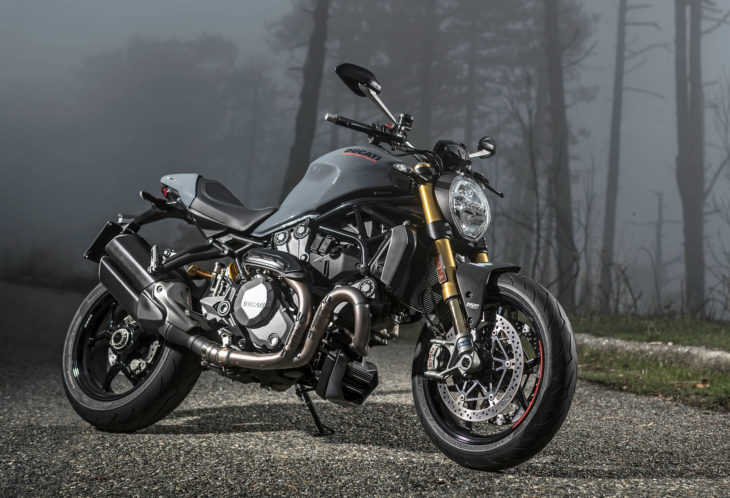
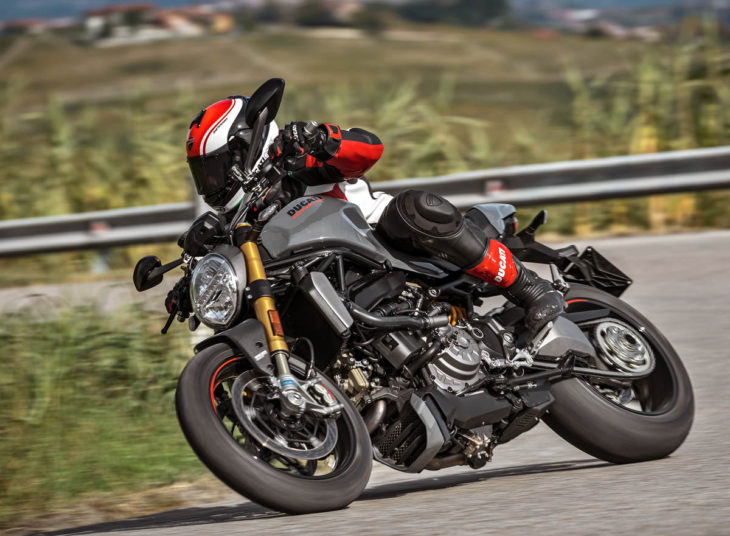
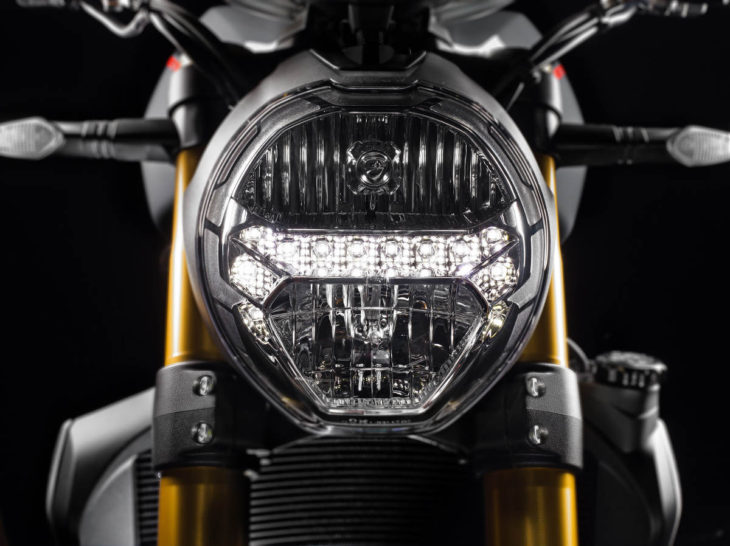
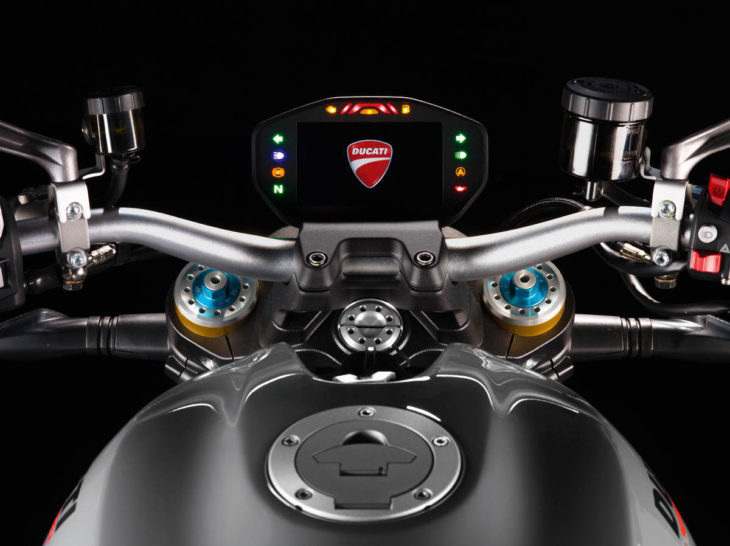
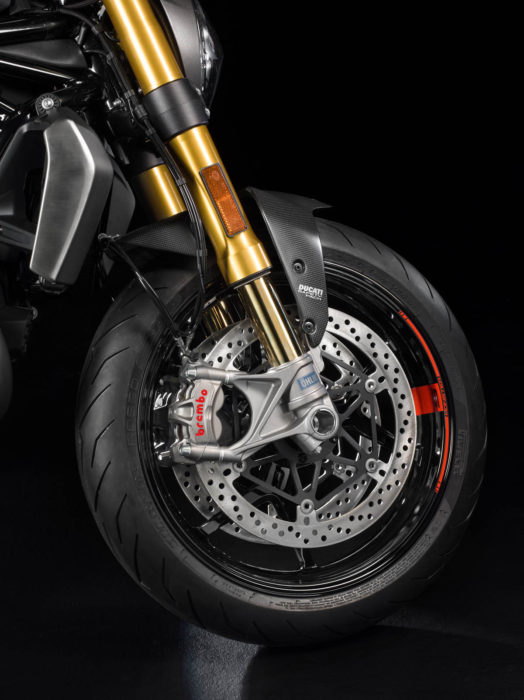






wait, i still see those hideous “curly fry” headers. it would only be “redesigned” if they left those out.
Amazing photo at the top of the page, marred only by the ugly gray blob of a bike blocking the wicked shot of the Blair Witch forest.
It’s a good looking bike, and probably a hoot to ride, but is this class really that big? How many people can really ride a 150 hp naked/standard the way it is intended? In the Northwet, nakeds just aren’t practical. So you’re basically looking at a bike that’s practical for year round use in the south. Of course if you look at it as a toy good for 3 months a year, then I can see it. A 120 hp Monster did seem sufficient, but I suppose if you’re competing with the super Duke, you have to bring a big gun to the fight.
Always the benchmark when it comes to standard motorcycle design to my eye.
Am disappointed. The new Monster is UGLY.
The original Monsters were much better looking bikes.
OK they were air cooled but at least their lines were clean.
The water cooled Monsters have hideous plumbing and they look “squashed” when viewed side-on
Ducati really needs to outsource their video work out to some motorcycle enthusiasts. Lets hear the engine and see some technical details or actual performance results.
Do you suppose they might be preaching to more than current motorcyclists?
You are correct as far as an annoying video. I didn’t even finish it.
I stopped reading at “In response to the increasingly competitive super naked category…”
Any adult that when asked what kind of bike they ride replies, “A super naked”, is unquestionably a priapic moron.
I will return to finish the article when I can summon my inner retard. To Ducati, please refrain from categorizing your otherwise excellent motorcycles as either “naked” or the even more ridiculous, “super naked”. Whoever types Ducati’s ad copy is dimwitted.
And people think (rightly so) that Harley’s ad copy is over the top and condescending.
On the positive side it doesn’t use bicycle wheels or tubes
Yup! Good one, Mick!
Good one, Mick!
…and it does not have a beak!
It’s barely got a front fender!
or TANK SEAMS…!!! (no Max Seamage here boys and girls)
“…is unquestionably a priapic moron.”
[prahy-ap-ik]
adjective
1. (sometimes initial capital letter) of or relating to Priapus; phallic.
2. characterized by or emphasizing a phallus:
priapic figurines.
3. (of an image) suggestive of or resembling a phallus by its shape.
4. exaggeratedly concerned with masculinity and male sexuality.
OK, I see what you mean by Super Naked.
Beautiful bike…
This is the kind of things that turn a rational “let’s buy an SV650” into “I’ll drive it in a civilized way…… yaaaaahooooooooooo wheelie…..”.
Can we get a straight side shot, please? That first picture is the same crazy low angle that turned so many people off to the XSR900 when it was introduced. The only bike that doesn’t look any worse from that angle is a cruiser…
The video seems to show lots of angles… not enough??
Actually no…there could be a few stills with decent angles.
http://monster1200.ducati.com/it_it/
the english version of the site is down for some reason…
I’m with you, Scott. There should always be a mandatory side view photo of new cars and bikes. I know photographers like their work to be artsy, but a vanilla side shot is still the best view, in most instances.